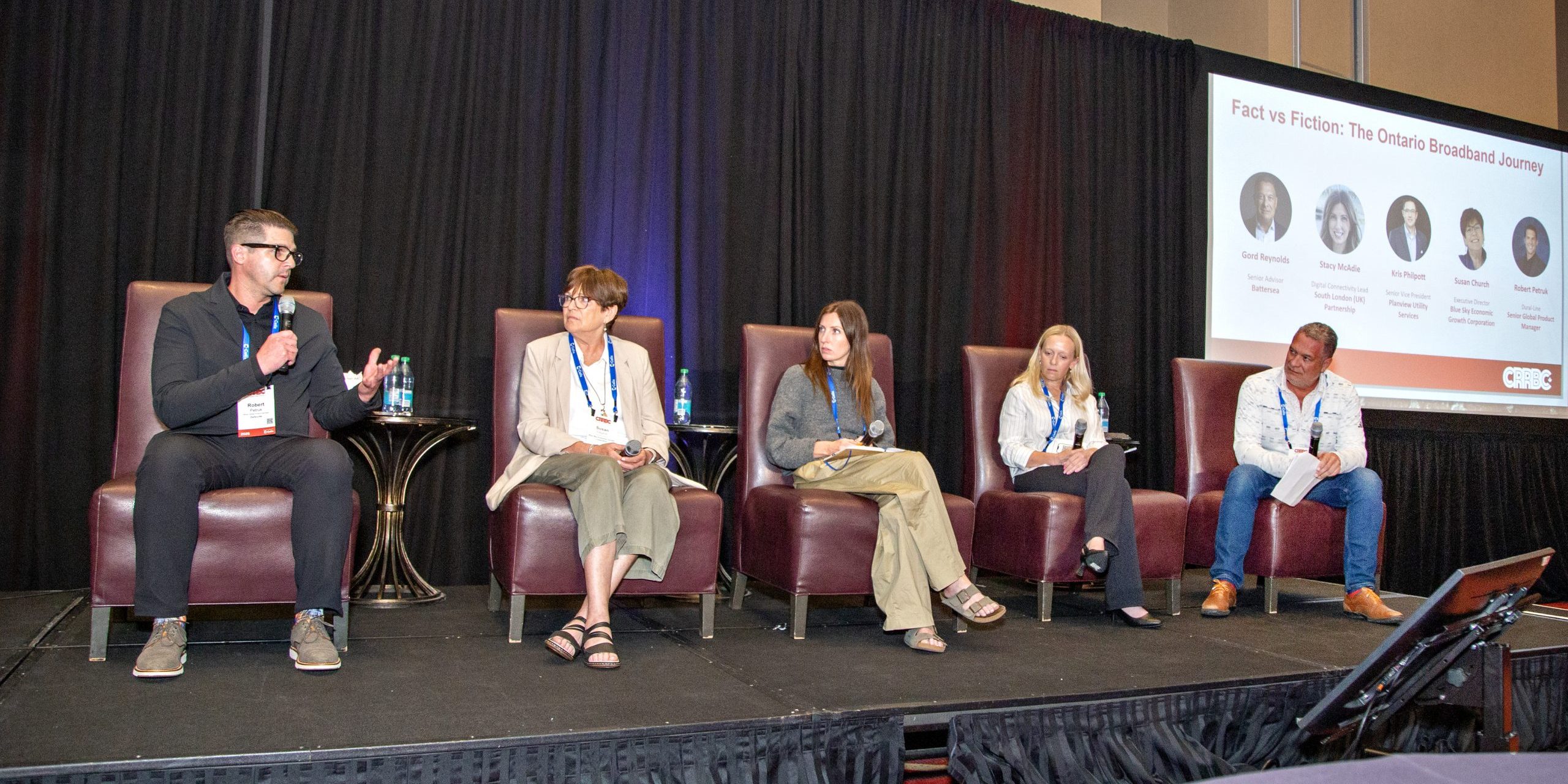
Ontario government plan to connect everyone to high-speed internet by end of 2025 might be too lofty a goal: CRRBC panel
Telecom | |June 12, 2025
ORILLIA, Ont.–The Ontario government’s goal of connecting everyone in the province to high-speed internet by the end of this year is facing challenges, say people familiar with connecting rural and remote communities.
One of the biggest problems, according to Susan Church of the Blue Sky Economic Growth Corporation/Blue Sky Net, is that “one size does not fit all” when it comes to federal and provincial broadband funding programs. Church made her observations during a panel exploring broadband connectivity in Ontario at a conference of Canada’s Rural and Remote Broadband Community (CRRBC) on Wednesday, June 11.
Ontario launched its accelerated high-speed internet program (AHSIP) in 2021, involving a pledge to provide all Ontarians to high-speed internet by the end of 2025 by allowing internet service providers (ISPs) to bid for subsidies for connecting defined geographic areas of the province. The government signed agreements with eight ISPs to connect communities.
But that end-of-2025 timeline is not likely to happen, said panel moderator Gord Reynolds, who was previously a vice president with Infrastructure Ontario until recently, and who played a role in developing broadband programming for the province.
“We don’t have much time left. The province committed to December 2025. I think we could all admit that’s going to be a miss,” said Reynolds, who is now an advisor with his own firm Battersea Advisory, and executive director of Digital Twin Ontario.
“Now it’s a question of do we redefine ‘done,’ or do we agree that there’s more work to do and it’s going to require more time?”
The Wire Report reached out to the provincial Ministry of Infrastructure asking whether the government expects it will meet that goal, and was directed to the Ministry of Energy and Mines as broadband now falls under its banner, according to an unnamed infrastructure spokesperson. The Wire Report has yet to receive a response from energy and mines.
(The CRTC, meanwhile, says Canada is on track to connect 100 per cent of households in the country with 50/10 Mbps internet service by 2030. That is according to its latest round of communications market reports.)
READ MORE:
– Closing Canada’s digital divide will take more than reaching 100% broadband coverage, says former CRTC head
– Funding gaps, policy shortfalls keeping rural Canada offline, experts say
– Wireless ISPs meet urban spectrum deadline, but face higher costs from looming rural transition
– Indigenous community leaders pitch need for thoughtful broadband collaboration at CRRBC conference
– Bell won’t participate in subsidized broadband projects if wholesale access for Big Three continues
While acknowledging that the creators of the Ontario subsidy program were well-intentioned, it still has its troubles, said Church.
She said a lot of existing incumbent small ISPs were not able to take part in the AHSIP program because the auction lots — the geographic areas selected by the province for bidding — were “too large for them to be able to properly service, even though they could have put forward an option to do a small piece of it…”
“I think that’s part of the challenge is that when we’re trying to fix [the connectivity gap], sometimes these programs are working in the reverse, and they’re actually creating a new problem, and that is overbuilding all of the existing internet service providers that are there,” Church said, referring to larger companies receiving government money to build in areas where smaller providers might already be selling service.
“And guess what they’re doing? Those local companies are hiring students. They’re training new employees. They are keeping employed families that have worked for years for them. First Nation communities in the Far North, they’re bringing a whole new skilled trade into the community. That’s how we expand things,” Church said.
“Again, it goes back to working together, [saying] ‘see this is already there,’ and see how we can make that even better,” she added, and was met with applause from the audience.
The issue of funding and service mapping in this country has been raised before, with some arguing overbuilding is an issue due to governments and the CRTC relying on outdated maps to determine which areas are in need of broadband funding and awarding funding to companies on that basis.
Reynolds brought the panel conversation to data mapping, asking Stacey McAdie, digital connectivity lead with the South London (U.K.) Partnership for her perspective on how things are done in the United Kingdom.
McAdie said parties there are sometimes operating in their own silos, “just doing their own projects, doing their own thing.” She said in some cases, money has been handed to projects “based on data that is either false or misrepresented.”
McAdie said there are financial hubs in London, for example, where it would appear from the available mapping that offices of major businesses who would most likely be big internet customers do not have access to fibre connectivity despite the scale of their business in that area, which she said would be unlikely.
Reynolds credited Church and her organization with having “solved the data problem” themselves in Ontario by building data sets that internet service providers and government could use to identify where problem areas exist.
Reynolds noted the province of Ontario signed a partnership agreement in Spring 2024 with the U.K. government to share information on that government’s work to create a more detailed registry of existing infrastructure through its “National Underground Asset Register.”
“It should be mandatory for infrastructure owners who build infrastructure for us on taxpayer dimes to share that information to us so that we can solve these problems, whether they be new transit, new highways, or broadband in communities. They should not be able to hold that data hostage and prevent us from moving forward, and we will not get there unless we agree on those basic rules as a barrier to us being able to solve for this,” Reynolds said.
“This is not about complaining, right? This is about getting real with what the problem that we’re facing is and what the solutions could be, and listening to people who live this day-in and day-out,” he said.
Church said that a group of representatives from northern Ontario and First Nations communities recently met to talk to the province’s Associate Minister of Energy-Intensive Industries Sam Oosterhoff about their concerns.
“The biggest challenge that came out of that discussion was that the big players who don’t want to play in the sandbox with the smaller players are a big part of what’s causing the problem. And if, for once, they get out of themselves and charge a reasonable rate for what it costs to use their transport, we would have this problem solved,” she posited.
“They’re not interested in playing in the north where the low-hanging fruit is no longer in their appetite. Why don’t you just open up the transport that is already there, from tip to stern, from North Bay to the James Bay coast, and back again and across?”, Church said regarding the potential for smaller players to access larger companies’ transport infrastructure in areas where they might not see a business case for investment.
“Why don’t you just open it up and allow the smaller players to be able to participate and use your transport where they could then build out what they need to do for the communities that are in need?”
Church argued that as long as government funds continue to give large telecoms money for rural and remote projects “and expect them to solve this problem, it’s not going to happen.”





